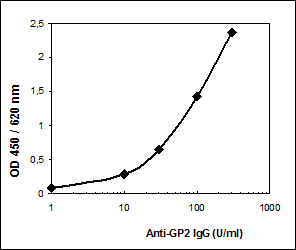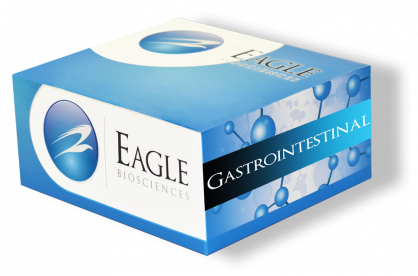Anti-GP2 IgG ELISA Kit
Anti-GP2 IgG ELISA Kit Developed and Manufactured by Medipan
Size: 1×96 wells
Sensitivity: 1 U/ml
Dynamic Range: 1 – 300 U/ml
Incubation Time: 1.5 hours
Sample Type: Serum, Plasma
Sample Size: 10 µL
Alternative Names: Glycoprotein 2
For Research Use Only
Assay Principle
The Anti-GP2 IgG ELISA Assay Kit is an enzyme immunoassay for the quantitative determination of IgG antibodies to glycoprotein 2.
The antibodies of the calibrators, positive control, and diluted patient samples react with the antigen immobilized on the solid phase of microtiter plates. After an incubation period of 60 min at room temperature (18…25°C), unbound serum components are removed by a wash step. The bound IgG autoantibodies react specifically with anti-human-IgG-antibodies conjugated to horseradish peroxidase (HRP) within the incubation period of 30 min at room temperature. Excessive conjugate is separated from the solid-phase immune complexes by the following wash step.
HRP converts the colorless substrate solution of 3,3’,5,5’-tetramethyl¬benzidine (TMB) added into a blue product. This enzyme reaction is stopped by dispensing an acidic solution (H2SO4) into the wells after 15 min at room temperature turning the solution from blue to yellow.
The optical density (OD) of the solution at 450 nm is directly proportional to the amount of specific antibodies bound. The standard curve is established by plotting the concentrations of the antibodies of the calibrators (x-axis) and their corresponding OD values (y-axis) measured. The concentration of antibodies of the specimen is directly read off the standard curve.
Related Products
Anti-GP2 IgA ELISA Kit
Anti-Beta 2 GP-1 (Glycoprotein 1) ELISA Assay Kit
Anti-GP2 (Glycoprotein 2) IgG ELISA Assay Kit



